#Ulster Volunteer Force (UVF)
Text
#OTD in 1975 – Miami Showband massacre | UVF volunteers (some of whom were also UDR soldiers) shot dead three members of an Irish showband at Buskhill, Co Down.
Three members of the Miami Showband are killed by Ulster Volunteer Force members posing as members of the security forces when returning from a performance at The Castle Ballroom in Banbridge, Co Down. (Four of the killers were actually members of the Ulster Defence Regiment (UDR), an official reserve force for the British army). At the time, the Miami Showband were one of the most popular…
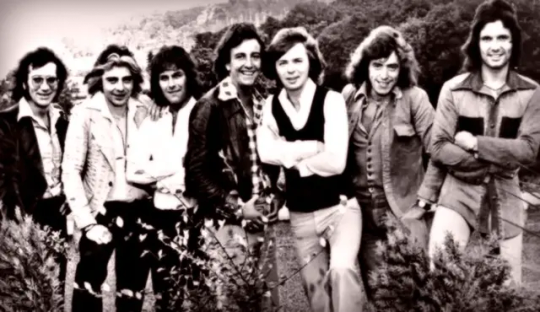
View On WordPress
#Banbridge#Brian McCoy#Co. Down#Dublin#Fran O’Toole#Monument#Parnell Square North#The Castle Ballroom#The Miami Showband#Tony Geraghty#UDR#Ulster Defence Regiment#Ulster Volunteer Force#UVF
9 notes
·
View notes
Text
Brother of man murdered by UVF paramilitaries to sue police and the Ministry of Defence.
Brother of man murdered by UVF paramilitaries to sue police and the Ministry of Defence.
http://seachranaidhe-irishandproud.blogspot.com/2022/10/brother-of-man-murdered-by-uvf.html
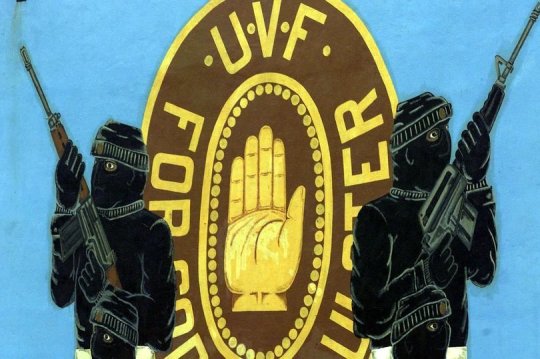
View On WordPress
#Belfast#Collusion#loyalist car bomb#Ministry of Defence (MoD)#Orange Loyalist Association (OLA)#Orange Volunteers (OV)#Patrick &039;Packy&039; McKee (civilian)#Troubles#U#Ulster Volunteer Force (UVF)
0 notes
Text
1974 –Dublin and Monaghan bombings

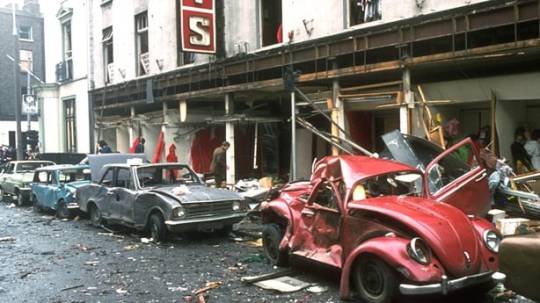
Thirty-three civilians are killed and 300 injured when the Ulster Volunteer Force (UVF) detonates four car bombs in Dublin and Monaghan, Republic of Ireland.

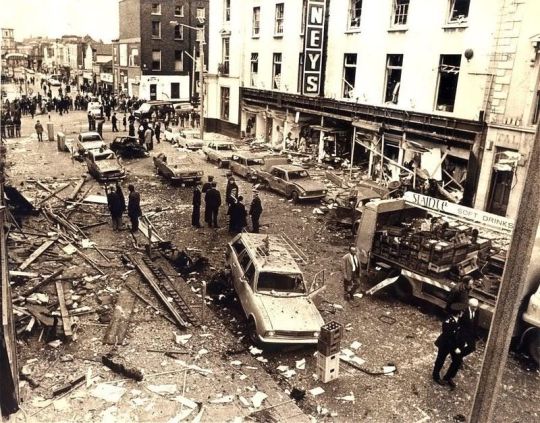

11 notes
·
View notes
Video
The Ulster Volunteer Force won't surrender... by National Library of Ireland on The Commons
Via Flickr:
Sir Edward Carson inspects a Browning Machine gun mounted on a motor car while members of the original UVF stand on parade. It is striking to see the machine gun mounted thus when we have become familiar with the images of military vehicles all over the world and especially in Africa seemingly festooned with such weapons! Sadly many of those who stood to attention in the background went on to die in the blood, mud and gore of the Somme just a few years later! Photographer: W. D. Hogan Collection: Hogan Wilson Collection Date: Not dated but circa 1913 - 1914 NLI Ref.: HOG240 You can also view this image, and many thousands of others, on the NLI’s catalogue at catalogue.nli.ie
2 notes
·
View notes
Text
The Troubles in Northern Ireland
Our first day in Ireland started when our plane touched down in Dublin at around 4:30 in the morning! We had to wait on the plane until closer to 5:00 for customs to open. From there, we boarded a bus and began our journey to Belfast. It is a beautiful city, and there’s so much to learn about it. Something pretty important is its location. When walking down Shankill Road, I made a comment to Clara about being in Ireland. A younger school boy walking near me turned and corrected me, saying “You’re not in Ireland, you’re in Northern Ireland!” His accent was thick and his sentiment was clear; this distinction is important to people who live here.
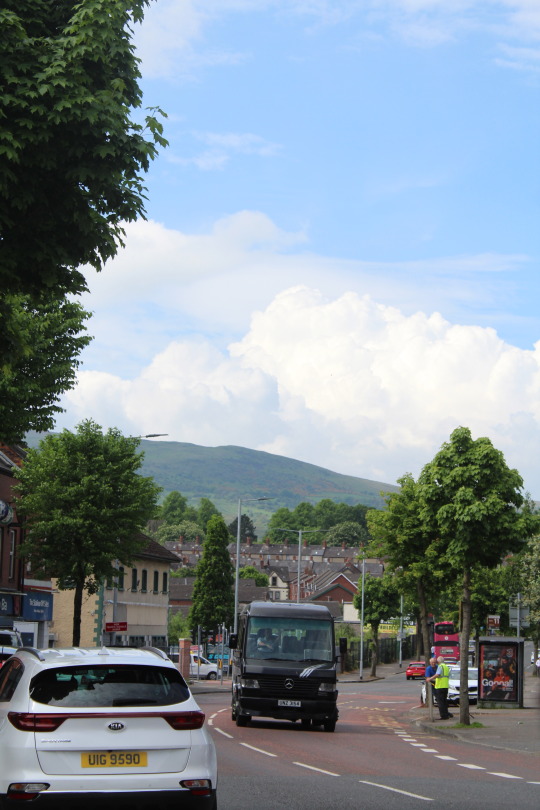
One of the first things we did in the city was take a Black Taxi Tour. Our two drivers, being from different religious backgrounds, were able to provide us different views on the opposing forces involved in the troubles. The two men used incredibly different language to describe the fighting groups. One saw the I.R.A. as protectors and kind of a police force, while the other saw them as drug-dealers and some sort of mafia. They also showed us both sides of the peace wall. Both of them believed that the peace wall, and its gates that close every night, was still needed; however they both shared a desire for a future without them. The necessity of these gates shocked me. On the protestant side, houses were far from the wall, while on the catholic side the houses were right up against it. In fact, some of them had cages over their back gardens to prevent attacks from things like molotov cocktails. These two sides of the wall painted a very clear picture of what life was like for these two groups of people.
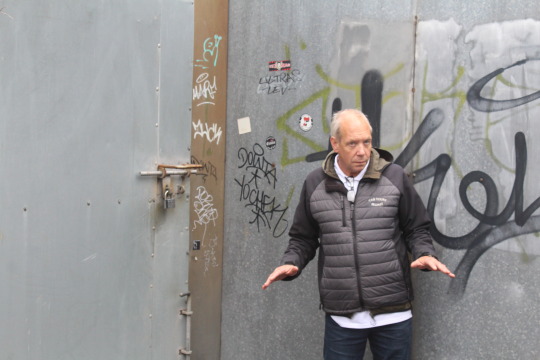
On Thursday, we were able to get a different perspective of the Troubles. We spoke with William from the ACT Initiative about his time in the Ulster Volunteer Force, and he gave a more political history of the Troubles, along with a deeper look at his own personal experiences during the time period. He shared that he was in prison from the ages of 17 to 30 because of his involvement with the UVF. During that he missed out on a lot of opportunities, like going to university. Now, however, he is able to help young people in situations similar to his. He obviously very deeply cared about his community and the people in it. The room that I found the most interesting was the recreation of the cell he was in. The room reminded me quite a bit of the site-specific installation art I learned about in my Contemporary Art class. Everything in it was authentic to the time period, down to the letters on the shelf and the notice his mother received of when his trial would be. Everything, except for a poster from the 2021 Long Kesh Reunion—which is signed by his fellow former inmates.
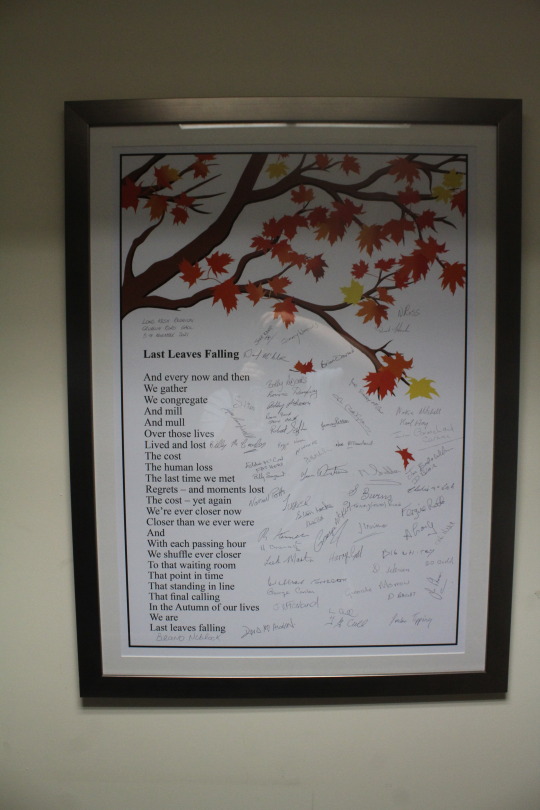
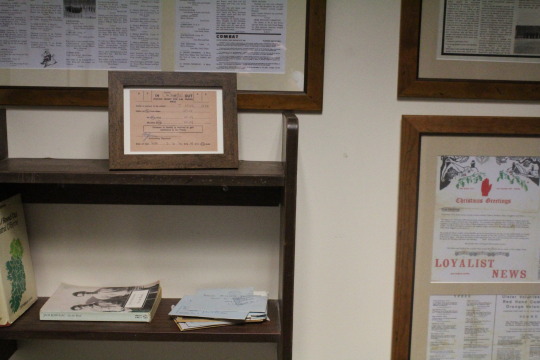
1 note
·
View note
Text
Events 5.17 (after 1970)
1973 – Watergate scandal: Televised hearings begin in the United States Senate.
1974 – The Troubles: Thirty-three civilians are killed and 300 injured when the Ulster Volunteer Force (UVF) detonates four car bombs in Dublin and Monaghan, Republic of Ireland.
1974 – Police in Los Angeles raid the Symbionese Liberation Army's headquarters, killing six members, including Camilla Hall.
1977 – Nolan Bushnell opened the first Chuck E. Cheese's Pizza Time Theatre (later renamed Chuck E. Cheese) in San Jose, California.
1980 – General Chun Doo-hwan of South Korea seizes control of the government and declares martial law in order to suppress student demonstrations.
1980 – On the eve of presidential elections, Maoist guerrilla group Shining Path attacks a polling location in Chuschi (a town in Ayacucho), starting the Internal conflict in Peru.
1983 – The U.S. Department of Energy declassifies documents showing world's largest mercury pollution event in Oak Ridge, Tennessee (ultimately found to be 4.2 million pounds [1.9 kt]), in response to the Appalachian Observer's Freedom of Information Act request.
1983 – Lebanon, Israel, and the United States sign an agreement on Israeli withdrawal from Lebanon.
1984 – Prince Charles calls a proposed addition to the National Gallery, London, a "monstrous carbuncle on the face of a much-loved and elegant friend", sparking controversies on the proper role of the Royal Family and the course of modern architecture.
1987 – Iran–Iraq War: An Iraqi Dassault Mirage F1 fighter jet fires two missiles into the U.S. Navy warship USS Stark, killing 37 and injuring 21 of her crew.
1990 – The General Assembly of the World Health Organization (WHO) eliminates homosexuality from the list of psychiatric diseases.
1992 – Three days of popular protests against the government of Prime Minister of Thailand Suchinda Kraprayoon begin in Bangkok, leading to a military crackdown that results in 52 officially confirmed deaths, hundreds of injuries, many disappearances, and more than 3,500 arrests.
1994 – Malawi holds its first multi-party elections.
1995 – Shawn Nelson steals an M60 tank from the California Army National Guard Armory in San Diego and proceeds to go on a rampage.
1997 – Troops of Laurent-Désiré Kabila march into Kinshasa. Zaire is officially renamed Democratic Republic of the Congo.
2000 – Arsenal and Galatasaray fans clash in the 2000 UEFA Cup Final riots in Copenhagen
2004 – The first legal same-sex marriages in the U.S. are performed in the state of Massachusetts.
2006 – The aircraft carrier USS Oriskany is sunk in the Gulf of Mexico as an artificial reef.
2007 – Trains from North and South Korea cross the 38th Parallel in a test-run agreed by both governments. This is the first time that trains have crossed the Demilitarized Zone since 1953.
2010 – Pamir Airways Flight 112 crashes in Afghanistan's Shakardara District, killing 44.
2014 – A military plane crash in northern Laos kills 17 people.
0 notes
Text
Remembering the Victims of the Dublin-Monaghan bombings.
The Dublin and Monaghan bombings were a series of coordinated bomb attacks that took place on May 17, 1974, during the Troubles in Ireland. These attacks are considered the deadliest in the history of the conflict, resulting in the highest number of casualties on a single day. 34 people were killed that day, 33 civilians and an unborn child.
The Ulster Volunteer Force (UVF), a loyalist…

View On WordPress
1 note
·
View note
Text
Gold Smackdown!
Loopy Ira (Matt Besser) and Howard "The Douche" Tuttleman (Nick Kroll) are two shock jocks of a morning zoo-fashion Pawnee radio program. 401k to gold ira rollover anticipated a redrawing of the border would end in much of the south and west of Northern Eire changing into part of the Free State, making Northern Ireland economically non-viable, and facilitating the reunification of the 32 counties in the near future. In early 1922, there were clashes alongside the new border between the IRA on the Southern aspect and Ulster Special Constabulary (USC) on the Northern aspect, in addition to a resurgence of sectarian violence in Belfast.
Since June 1920, communal battle had been raging in north-east Ulster between the Protestant unionist majority there, who wished to stay part of the UK, and the Catholic Irish nationalist minority, who backed Irish independence. The Irish Volunteers have been created in the same yr by nationalists in response to the formation of the Ulster Volunteers (UVF), an Ulster loyalist body pledged to oppose Dwelling Rule by power. At that time Wilson had served as military advisor to the Northern Eire authorities led by James Craig, in which function he was seen to be accountable for the B-Specials and for different sources of loyalist violence in the north. Mackay, James (1996). Michael Collins - A Life. Michael Collins as Commander-in-Chief of the Irish National Forces.
Collins was decided to avoid the large destruction, army and civilian losses for merely symbolic victories that had characterised the 1916 Rising. After recurring closely throughout the present's sixth season, Eichner was promoted to a starring cast member in the seventh season, beginning with the fourth episode "Leslie and Ron". Billy Eichner who portrays Craig Middlebrooks, the "associate administrator" of the Pawnee parks division, recurred all through the present's sixth season until he was promoted to the principle solid within the fourth episode of the seventh season. https://okcheartandsoul.com/entertainment/opinions-of-the-top-rated-gold-ira-companies-for-2023/ (Billy Eichner) is the previous office supervisor of Eagleton's parks department, the equivalent of Donna's position in Pawnee.
Parks and Recreation. Season 3. Episode 11. Event occurs at 12:53-13:01. NBC. Joe Biden: appeared within the Season 5 episode "Leslie vs. April". research gold iras , Steve (January 21, 2010). "Parks and Recreation: "Leslie's Home"". Hanks, Henry (Could 20, 2011). "Bye-bye, Li'l Sebastian on 'Parks and Rec'". A British Military area marshal, Wilson had not too long ago resigned his fee and been elected an MP for a constituency in Northern Ireland.
0 notes
Text
Yearly reminder that if your idea for celebrating St. Patrick's Day is to get wasted on "Irish car bombs" at a bar, then you should go fuck yourself, you Loyalist prick
The Hillcrest Bar bombing, also known as the "Saint Patrick's Day bombing", took place on 17 March 1976 in Dungannon, County Tyrone, Northern Ireland. The Ulster Volunteer Force (UVF), a loyalist paramilitary group, detonated a car bomb outside a pub crowded with people celebrating Saint Patrick's Day. Four Catholic civilians were killed by the blast—including two 13-year-old boys standing outside—and almost 50 people were injured, some severely.
0 notes
Text
I terroristi hanno messo un bersaglio sulla mia schiena
I terroristi hanno messo un bersaglio sulla mia schiena
L’impunità inquina e indebolisce le democrazie. I racconti di questi moniti in Irlanda del Nord, e nel resto d’Europa, sono troppo numerosi per essere ignorati. L’azione è attesa da tempo per garantire che tutti i giornalisti siano protetti.
La democrazia senza la libertà dei media non è affatto una vera democrazia.
Patricia Devlin dalle pagine di Open Democracy
Come molti giornalisti in Irlanda…
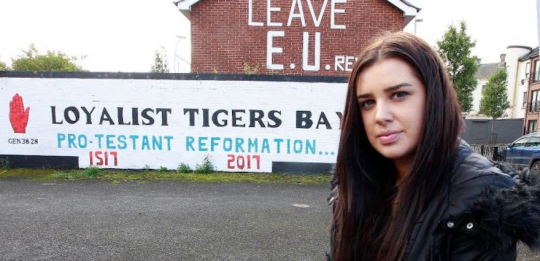
View On WordPress
#featured#giornalismo#gruppi paramilitari lealisti#irlanda del nord#libertà di stampa#Loyalist Volunteer Force#LVF#Open Democracy#Patricia Devlin#UDA#Ulster Defense Association#Ulster Volunteer Force#uvf
0 notes
Text
#OTD in 1998 – The three Quinn brothers, Richard, 11, Mark, 10, and Jason 9, are burned to death by a Loyalist firebomb in Ballymoney, 40 miles northwest of Belfast.
Ar dheis Dé go raibh a n-anamacha.
Jason, Richard and Mark Quinn were three brothers killed by the Ulster Volunteer Force (UVF) in a firebomb attack on their home in Ballymoney, Co Antrim.
Garfield Gilmour, was found guilty of murdering the three brothers 15 months later and sentenced to life imprisonment after admitting that he had driven three other men to the house to commit the fatal…

View On WordPress
#Ballymoney#Ballymoney Times#Carnany#Co. Antrim#Drumcree#Drumcree conflict#Ian Paisley#Jason#Mark#Orange Order#Petrol Bomb#Quinn Brothers#Quinn Family#Rasharkin#Richard#The Troubles#Ulster Volunteer Force#UVF
10 notes
·
View notes
Text
Mid Ulster Brigade Ulster Volunteer Force
This Portadown mural combines the Ulster Volunteers of 1912 with the contemporary UVF. The panels show “UVF gun-smuggler 1913”, “Firearms training 1913”, and “Sir Edward Carson about to address troops at Portadown railway station” while the roll of honour lists modern-day volutneers Joey Neill, Horace [Harris] Boyle, Wesley Summerville [Somerville], Derek McFarlane, Jackie Marshall, Wilson…

View On WordPress
0 notes
Text
1994-Loughinisland massacre
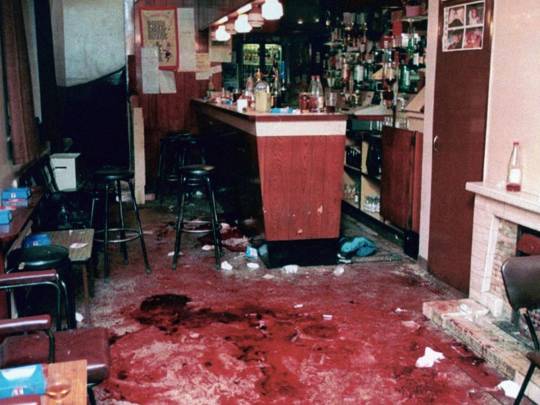

Members of the Ulster Volunteer Force (UVF) attack a crowded pub with assault rifles in Loughinisland, Northern Ireland. Six Catholic civilians are killed and five wounded. It was crowded with people watching the 1994 FIFA World Cup.
0 notes
Text
dispatch on the unrest in belfast
in the late 1950s a group of British Army soldiers from Northern Ireland became notorious for butchering civilians in Cyprus. they were defending the British occupation from the EOKA, led by (no, really) General Grivas, who wanted reunification with Greece. despite Grivas attempts to prevent it the war quickly became a sectarian conflict between Christian Greek Cypriots and Muslim Turkish Cypriots. it was an extremely bloody conflict fought with civilian lives. for the first time in war the pipe bomb replaced the heavy artillery.
when the British surrendered in 1960 those soldiers returned home and, in order to combat the Catholic civil rights movement, became involved in civilian loyalist organisations like the Loyal Orange Lodge until in 1966 when they formed the paramilitary Ulster Volunteer Force (UVF). their innovation was to apply the experience in Cyprus to Northern Ireland to defend a partition which was not, at this stage, actually under attack. that year they carried out a string of random killings on the Catholic Falls Road. the civil rights movement developed into an armed struggle for national liberation, the British Army was deployed to combat it, and the UVF were transformed into anonymous soldiers for apartheid, armed by the South African regime, among others, and receiving clandestine support from the British.
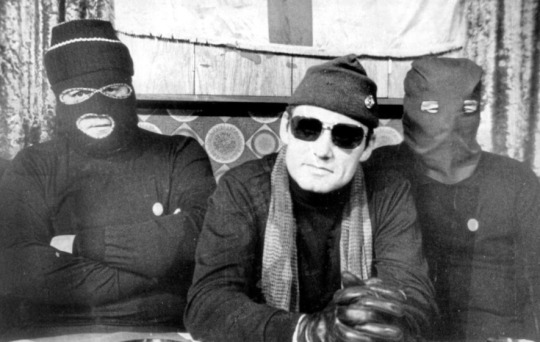
pictured: Gusty Spence, first prince of loyalist terror, flanked by his retainers
when Gusty Spence, the leader of the UVF, was caught and imprisoned, he gradually lost control of the organisation. by the end of the 70s it had turned from a politically motivated death squad into an organized crime syndicate and was competing with several other paramilitary rackets, especially the UDA who still control the drug trade in Protestant areas. when Gusty Spence got out of prison he and several other former UVF brigadeers would join the Progressive Unionist Party, which combined loyalism with socialism. they were instrumental in negotiating the ceasefire known as the Good Friday Agreement in the 90s.
the sectarian killings died down but never disappeared. the far-right DUP, led by arch-reactionary Ian Paisley and maintaining secretive associations with both the Loyal Orange Lodge and the UVF (alongside Paisley’s several failed attempts to create his own paramilitary organization known as Third Force), became the dominant unionist party and the dominant party in Stormount, while Sinn Feinn, the political wing of the Provisional IRA, had become the leading republican party throughout the 1980s. apart from a few weak gestures they both agreed on a bunch of austerity cuts and fought tooth and nail against abortion and so on, reiterating the “carnival of reaction north and south” in microcosm.
throughout the 2000s a lot changed. the sectarian Royal Ulster Constabulary was disbanded and replaced with the dysfunctional Police Service Northern Ireland. the loyalist paramilitaries generally decomissioned as requested. it seemed like things were changing. by 2011 the final report of the Independent Monitoring Comission was cautiously optimisitc, writing that “In our first year [2004], each week there were on average four victims of paramilitary violence, some in sectarian incidents. In the last six-monthly period on which we reported the number was about a third of that and none were sectarian” (IMC, pg. 14). but already in 2003 Peter R. Neumann, a researcher on terrorism and partisan conflict, predicted that “the current peace process may not be the ending of the conflict but the suppression of it into the politics of threat and coercion” (Neumann, Britain’s Long War, pg. 1). fifty years after Marcuse was worried about ‘repressive desublimation’ in America, we were finally enjoying the good old ‘disciplinary society’ in Northern Ireland.
the loyalist paramilitaries went through a profound involution, becoming ethnoreligious dictatorships with exclusive police authority over the communities they claim to represent, battling among each other for control over housing estates. they possessed exclusive control over the black market, forced all businesses to pay them protection, and controlled most commercial services (taxi cabs, window cleaners, and so on). they exiled troublemakers, wounded lawbreakers, and murdered their opponents. your neighbours are taken away in the middle of the night and no one asks what happened. you wake up to breaking glass and gunshots, but no screams. then the paramilitaries appropriate the house of their victim and lease it out themselves. the IMC make an uncharacteristically wry remark that this is just “one amongst many ways in which paramilitaries continued to do what they had always done, namely doing violence to their own communities.” (IMC, pg. 14)
The Comission writes that “when we started we observed a scene from which terrorism against the organs of the state had largely disappeared,” yet “as we close we see classic signs of insurgent terrorism” (IMC, pg. 15). the very next year, in December 2012, the UVF and UDA were able to mobilize a huge crowd of Protestants in a campaign of civil disobedience over the removal of the Union Jack from City Hall. this was the first time since the partition that loyalism had taken on the appearance of a genuinely popular movement, looking more like Catholic civil rights marchers of the 60s than Black & Tans. the transformation of loyalism into a form of militant political activism with its own demo circuit was one of a few significant changes of the last decade (we won’t have time for the others in this post). throughout the 2010s they carried out agitprop, pamphleteering, posting up placards and organizing protests against the traitors, touts and frauds at Stormount, even training their own professional activists like Jamie Bryson, all soliciting Protestants to help them protect their cultural identity, heritage and the usual hogwash.
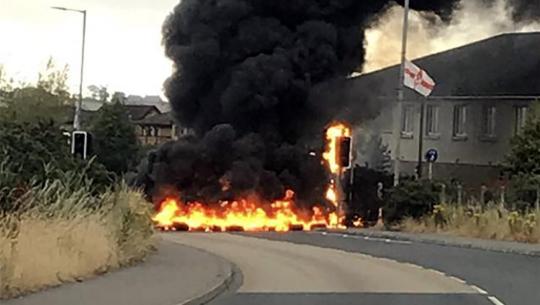
the sedition intensified when, on the 11th of July, 2018, in order to protest ... something, all over Co. Down and Belfast masked and armed volunteers hijacked busses and cars and burned them out, blockaded the roads with burning tires, and hid pipe bombs in the wreckage (BBC). but there was no pretension that this was an act of popular will. it all happened before 5am, and the UVF immediately contacted the police and the press to claim responsibility.
now on the seventh day of violent unrest in Belfast we find this tendency reaching its fullest expression. the events are widely reported on as ‘riots’, but the attacks are identical to the UVF sedition in 2018 and, anyway, require a level of organization which only a paramilitary possess. the difference is that in this instance, like in the Flag protests of 2012-2013, the paramilitaries were able to mobilize ordinary Protestants. but how mobilized are they?
“When the hostage espouses the cause of the terrorist ... then another justice is active than the justice of the law, other scales than the scales of justice.” (Baudrillard, Cool Memories V 2000-2004)
whenever an ordinary person is beaten, shot, exiled or killed by the UVF, our neighbours do not, as we do, hide under their beds and pray. instead, very often, they celebrate. they regard acts of terror as occasions for saturnalia; they come out into the street and cheer, they open buckfast or bacardi, they call their friends to let them know, and in their voices one hears earnest excitement. after the involution of terror we can no longer really blame this on the red mist of bigotry. it makes no difference to armoured Protestants whether the victim is enemy or friend. the order of the spectacle wins out over the mode of terror.
if one looks closely at the events in belfast, common people are present but they are spectators, not participants. elderly women and babies in prams along with their families line up along the sidewalk to watch and cheer while the professionals blow things up. if this is a riot, it’s a strange kind of riot. in some sense The Belfast Riots Did Not Take Place. the pipe bomb returns to Belfast as a simulation of the pipe bomb of the Troubles, already a simulation of the pipe bomb of the Cyprus Emergency, a retaliation to an attack that hasn’t happened yet. but pay close attention to the redirection that has taken place; the bomb is thrown, not into the window of a Republican bar, like the petrol bomb that killed Matilda Gould, but into a line of riot police, like the pipe bomb at the Haymarket riot.
so, what’s next?
some commentary has been made about the fact that the military has been deployed to settle the unrest. this seems like something new, perhaps the first time since the Good Friday Agreement. but, in fact, the military were already deployed in Northern Ireland from the beginning of COVID-19 to support the health services and supply logistics (BBC). it’s significant that they were not called in for the 2012-2013 Flag protests or the ‘Day of Disorder’ in 2018. the state of exception brought about by the pandemic has possibly adjusted the scales. furthermore, the military, previously arming and collaborating with the UVF, are now being deployed specifically to prevent them.
the IMC reported that very few of the killings, by 2011, were sectarian. the Flag protests were sectarian only indirectly, affirming the Protestant ‘siege mentality’, but the enemy was Stormont and not the specter of armed republican revolution. the 2018 disorder had no sectarian content at all. conversely, the incident which incited this week’s Belfast Riots was much more explicitly sectarian. it’s a lot of horseshit: they (prominently, the DUP) wanted Michelle O’Neill, Deputy First Minister and member of Sinn Feinn, arrested for violating COVID restrictions to go to a funeral. the riots began the day the PPS decided not to prosecute. the contention is that COVID restrictions are being unequally enforced between Protestants and Catholics. a paranoid inversion of the real inequality was typically a justifciation for sectarian violence during the Troubles. in one of the most violent moments of the riot the Lanark Way peace wall, separating the Falls and the Shankill, was set on fire and breached, Protestant rioters storming the Catholic street and attacking its residents (the Guardian).
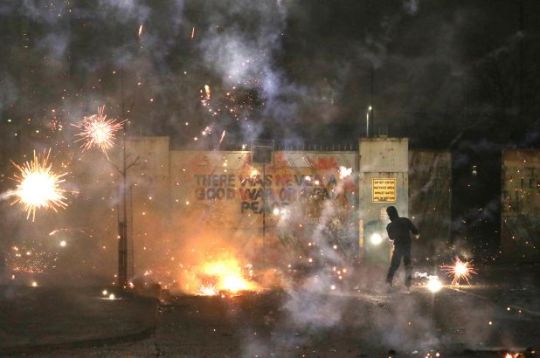
is this the last gasp of an old order of sectarian violence, quickly being replaced by a new kind of reactionary populism? or are these the early ripples of a new, increasingly violent sectarian resurgence? will the tensions between the UVF and the British Army continue to escalate, or will the civil war transform into an ethnic conflict, like in Cyprus? we cannot anticipate the outcome. but the last 6 days seem like significant ones to me. we should remain sensitive to the changes that are coming.
130 notes
·
View notes
Note
do you know of any cults/programming sites in tyrone northern ireland from 2006 onwards? ty
The Nameless House Church, the Friends, the Dippers, the Secret Sect, Pilgrims, Tramp Preachers, the Jesus-Way, Reidites and Irvinites. They are sometimes called ‘Cooneyites’ after one of their early leading preachers. One cult group has been labeled with those names.
The Irish Raelian movement, the UFO religion that was founded in 1974 by Claude Vorilhon, now known as Raël. The movement teaches that life on Earth was created by a species of extraterrestrials.
The Palmarian Church, a highly secretive Spanish sect that broke away from the Catholic Church and has declared a series of its own 'Popes'.
The Universal Church of the Kingdom of God (UCKG), a small presence in the Republic of Ireland, however it has no permanent base in Northern Ireland.
White supremacist groups for example Combat 18.
Ulster Volunteer Force is still active, as well as The Ulster Defence Association. The assessment says there are about 7,500 people in the UVF and 5,000 in the UDA.
There are a number of groups. You didn’t mention a belief system or branch of military so this is an brief overview of that area.
Oz
3 notes
·
View notes